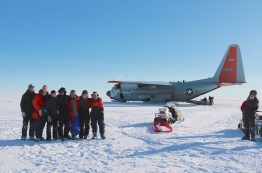New research reveals significant changes to the circulation of the North Pacific and its impact on the initial migration of humans from Asia to North America. The international study, led by the University of St. Andrews in Scotland and published Dec. 9 in Science Advances, provides a new picture of the circulation and climate of the North Pacific at the end of the last ice age, with implications for early human migration.
Read more at UW News »A.I. model shows promise to generate faster, more accurate weather forecasts
Today’s weather forecasts come from some of the most powerful computers on Earth. The huge machines churn through millions of calculations to solve equations to predict temperature, wind, rainfall and other weather events. A forecast’s combined need for speed and accuracy taxes even the most modern computers. The future could take a radically different approach. A collaboration between the University of Washington and Microsoft Research shows how artificial intelligence can analyze past weather patterns to predict future events, much more efficiently and potentially someday more accurately than today’s technology.
Read more at UW News »UW announces Maggie Walker Deanship in the College of the Environment
The University of Washington today announced a major gift that elevates the importance of climate change and secures the legacy of Seattle philanthropist Maggie Walker by creating a namesake deanship for the College of the Environment. Honoring her life of service and commitment to the UW, in addition to an initial 10-year pledge of more than $400,000 annually, the Maggie Walker Deanship will provide a stable source of discretionary funding for the incoming dean and attract world-class talent to the fill the position.
Read more at UW News »Ice within Mount Everest holds key to the past, hints at future
Last year for International Mountain Day, we visited the shores of Mauna Kea in Hawaii and learned that it’s the tallest mountain in the world when measured from the base underwater up to the top. This year, we are travelling to colder climates to the highest mountain in the world when measured from sea level: Mount Everest. Department of Earth and Space Sciences’ Howard Conway officially had one of the most scenic offices in the world when he conducted field work on the Khumbu Glacier, one of the four major glaciers that flank Mount Everest.
Read more »NSF-funded deep ice core to be drilled at Hercules Dome, Antarctica
Antarctica’s next deep ice core, drilling down to ice from 130,000 years ago, will be carried out by a multi-institutional U.S. team at Hercules Dome, a location hundreds of miles from today’s coastline and a promising site to provide key evidence about the possible last collapse of the West Antarctic Ice Sheet. The National Science Foundation has funded the roughly five-year, $3 million project involving the University of Washington, the University of New Hampshire, the University of California, Irvine and the University of Minnesota.
Read more at UW News »





